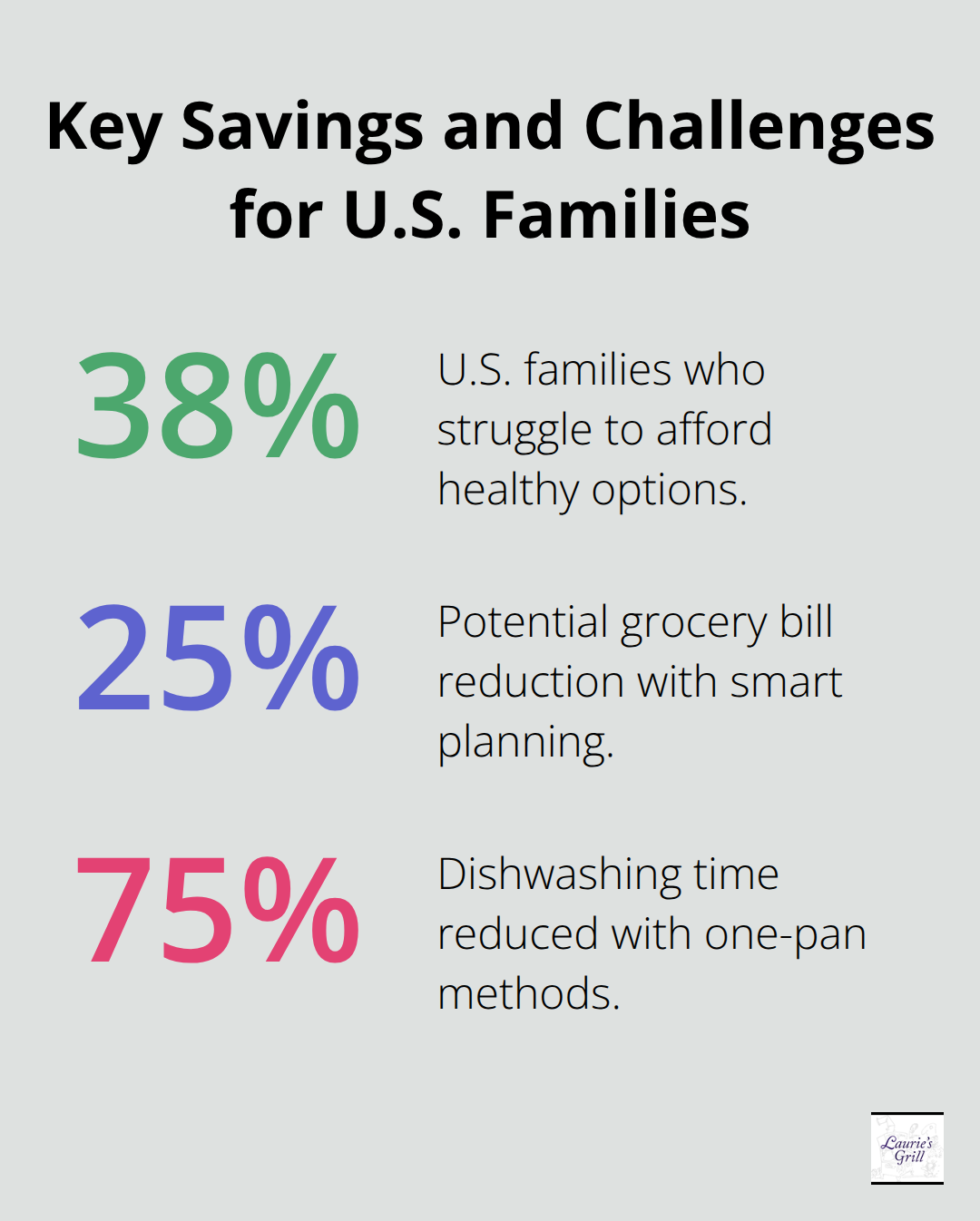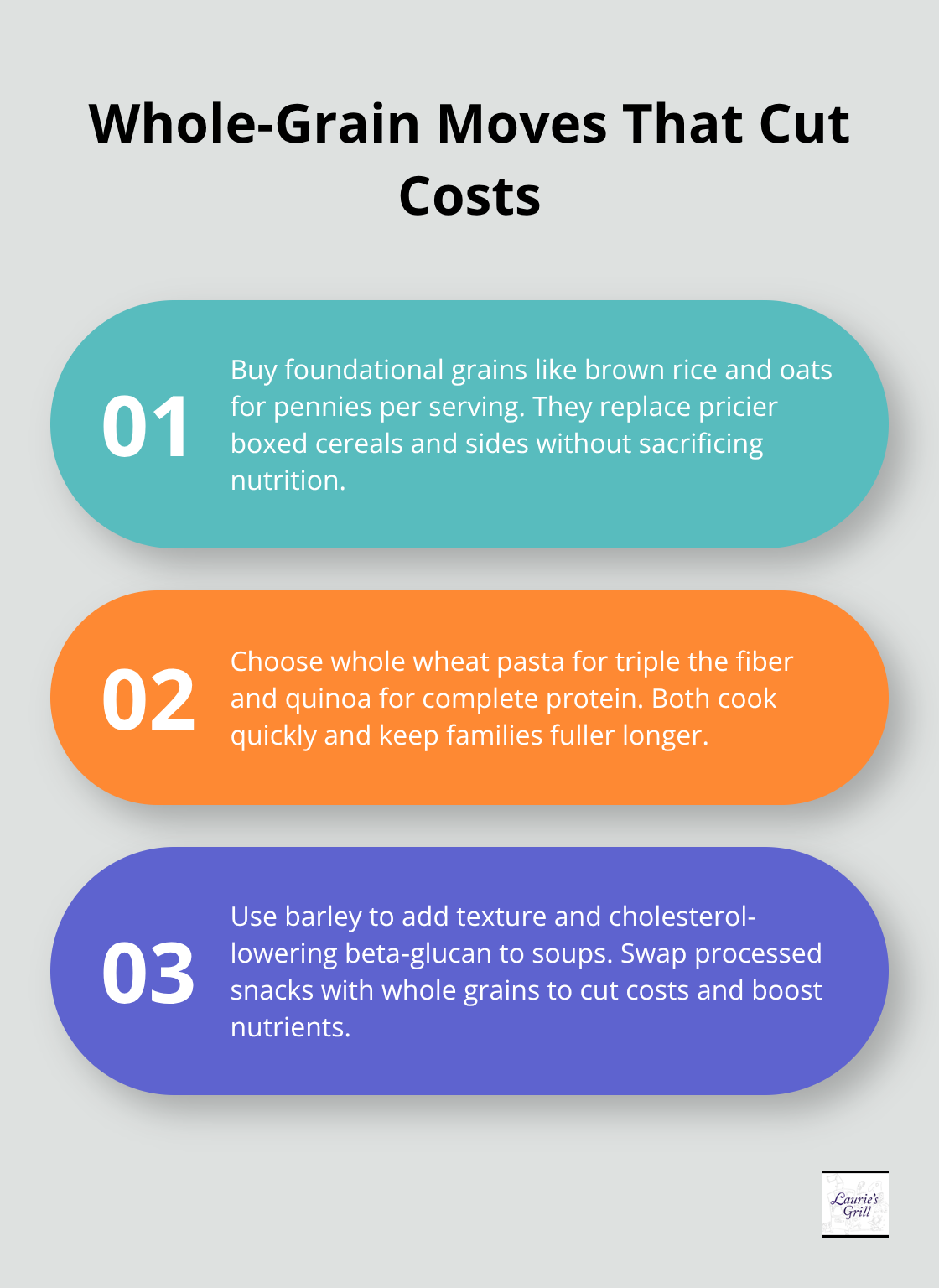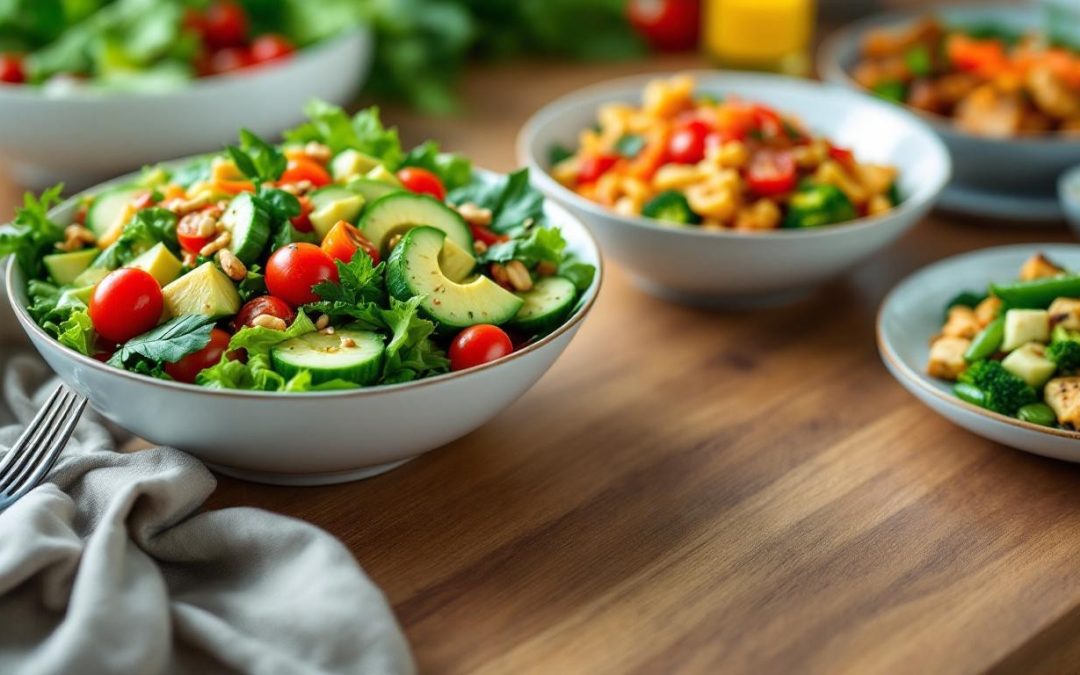Feeding your family nutritious food shouldn’t break the bank. The average American family spends $7,729 annually on groceries, yet 38% struggle to afford healthy options.
We at Laurie’s Grill believe healthy affordable family meals are within reach for every household. Smart planning and simple techniques can cut your grocery bill by 25% while boosting nutrition.
How Do You Plan Meals That Actually Save Money?
Start with the Numbers That Matter
The USDA reports families waste food annually, which costs the average household $1,500. Strategic meal plans eliminate this waste while they reduce grocery costs by up to $2,000 yearly. Create your weekly menu around three core principles: protein rotation, starch variety, and seasonal vegetables. Plan seven dinners, five lunches, and three breakfast options that share common ingredients. Ground turkey works in tacos Monday, chili Wednesday, and pasta Friday.

Rice serves as a base for stir-fry Tuesday and stuffed peppers Thursday. This approach cuts your list from 40+ items to just 15-20 ingredients.
Master Seasonal Produce and Bulk Purchases
Seasonal produce costs less than out-of-season alternatives. Winter squash, root vegetables, and citrus fruits peak from November through March at $1-2 per pound versus $3-4 for summer berries. Stock up on 25-pound rice bags, 10-pound bean varieties, and bulk oats when they hit $0.50-0.75 per pound. Grocery apps like Ibotta and Fetch Rewards return 2-5% on receipts (active families save $150-300 annually). Target stores with double coupon days and match manufacturer coupons with store sales for maximum impact. Wednesday typically offers the best produce markdowns as stores prepare for weekend deliveries.
Transform Your Store Strategy
Store loyalty programs provide exclusive discounts worth 15-25% on targeted items weekly. Download your primary grocery store app and activate digital coupons before you shop. Compare unit prices religiously – the 5-pound chicken often costs less per pound than individual breasts. Shop ethnic markets for spices, rice, and produce at 30-50% below chain store prices. Dollar stores stock healthy options like canned tomatoes, whole grain pasta, and frozen vegetables at significant savings over traditional grocers (many families overlook these gems).
These smart choices set the foundation for your kitchen success, but the real magic happens when you master simple techniques that turn basic ingredients into nutritious family favorites.
Which Cooking Methods Save Time and Money?
Master Sunday Prep Sessions
Research shows that spending less than 1 hour daily on food preparation leads to significantly more money spent on food away from home and more frequent fast food use. Sunday afternoon transforms into your production kitchen when you cook three proteins simultaneously. Roast a whole chicken while ground turkey browns on the stovetop and hard-boiled eggs simmer. This single 90-minute session provides protein for 12-15 meals throughout the week. Chop vegetables in bulk during this time – dice onions, slice bell peppers, and wash greens. Store these components in glass containers for grab-and-go assembly during busy weeknights.

Pre-cooked rice and quinoa last five days refrigerated and reheat in two minutes.
One-Pan Victories Beat Multiple Dishes
Sheet pan dinners eliminate cleanup while they maximize flavor through caramelization. Toss chicken thighs with root vegetables, olive oil, and seasonings for a complete meal that costs $2.50 per serving. One-pot pasta dishes like chicken and broccoli alfredo cook entirely in a single Dutch oven, which creates natural starch thickening without extra steps. These methods reduce dishwashing time by 75% compared to traditional multi-pot cooking. Ground beef taco casserole stretches one pound of meat with beans and serves six people for under $8 total. Foil packet meals like pierogies with sausage cook on the grill or in the oven with zero cleanup required.
Protein Shortcuts That Actually Work
Rotisserie chickens from grocery stores cost $5-7 and yield meat for four different meals throughout the week. Remove the meat Sunday night and use it for chicken salad Monday, tacos Wednesday, and soup Friday. Canned fish provides omega-3s and supports heart, brain and joint health while remaining budget-friendly – mix tuna with white beans and vegetables for instant protein bowls. Eggs cook in three minutes and work for breakfast, lunch, or dinner at just $0.25 each (making them one of the most economical protein sources available). Ground turkey seasons identically to beef but costs 30% less per pound while it delivers leaner protein for growing families.
These time-saving techniques work best when you stock your pantry with the right ingredients that deliver maximum nutrition without premium prices.
Which Ingredients Give You Maximum Nutrition Per Dollar
Protein Powerhouses That Cost Pennies
Dried beans and lentils deliver complete nutrition at $1.50 per pound and provide 15-16 grams of protein per cooked cup. Red lentils cook in just 15 minutes and absorb flavors from curry spices or Italian herbs. Black beans cost $0.89 per can and contain more fiber than most vegetables while they match chicken breast for protein content. Eggs remain the gold standard at $0.25 each – scramble them for breakfast, hard-boil for salads, or bake into frittatas that feed six people for under $3. Canned tuna and salmon provide omega-3 fatty acids at $1.50 per can versus $8-12 for fresh fish. Greek yogurt contains double the protein of regular yogurt and works as a sour cream substitute in recipes (this saves $2-3 per container while it boosts calcium intake).
Vegetables That Multiply Your Investment
Cabbage costs $0.50 per pound and provides vitamin C, fiber, and volume for soups, slaws, and stir-fries. One head feeds a family of four across three different meals. Sweet potatoes deliver beta-carotene, potassium, and natural sweetness at $1.25 per pound – roast them whole, mash for sides, or slice for breakfast hash. Frozen mixed vegetables maintain nutrition levels identical to fresh options while they are convenient and cost-effective. Carrots, onions, and celery form the base for countless recipes at under $3 total cost. Winter squash varieties like butternut and acorn provide vitamin A and natural sweetness that reduces sugar cravings. These vegetables store for weeks without refrigeration, which extends their value beyond the initial purchase price.
Whole Grains Replace Expensive Processed Foods
Brown rice costs $2 per five-pound bag and cooks into 40 servings that provide sustained energy without blood sugar spikes. Oats transform into breakfast, cookies, and meatloaf binder at $3 per container versus $6-8 for processed cereals. Whole wheat pasta contains triple the fiber of white varieties while it costs the same price and keeps families satisfied longer. Quinoa provides complete protein and cooks in 15 minutes (making it perfect for quick grain bowls with leftover vegetables and proteins). Barley adds texture to soups and stews while it delivers cholesterol-lowering beta-glucan fiber.

These whole grains replace expensive processed snacks and convenience foods that offer minimal nutrition at premium prices.
Final Thoughts
Healthy affordable family meals become achievable when you combine strategic planning with smart cooking techniques. The three-step approach of meal planning, bulk purchases, and simple preparation methods can reduce your grocery spending by $2,000 annually while it improves your family’s nutrition. These changes compound over time as families who master these strategies report better health outcomes, reduced medical expenses, and stronger family bonds around shared meals.
The financial benefits extend beyond immediate grocery savings. Children who grow up eating home-cooked meals develop better eating habits that last into adulthood (potentially preventing costly health issues later). Your investment in learning these skills pays dividends for decades through improved family wellness and financial stability.
Start your transformation this Sunday with a simple meal plan and one batch cooking session. Choose three proteins, five vegetables, and two grains from your local store’s sale flyers. Cook them using the one-pan methods we’ve outlined, then watch your grocery bills shrink while your family’s health improves. We at Laurie’s Grill understand the importance of wholesome, budget-friendly meals that bring families together, and you can visit Laurie’s Grill to experience how classic American comfort food can inspire your own home cooking adventures.


Recent Comments